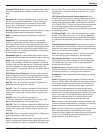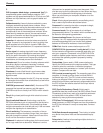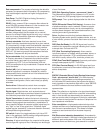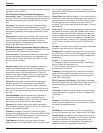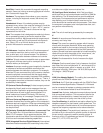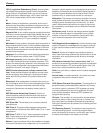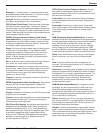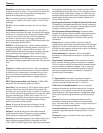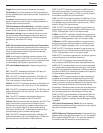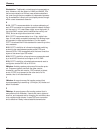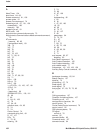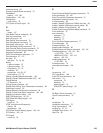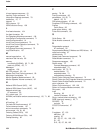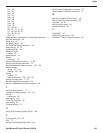
MultiModemISI Hybrid Series, ISIHI-2S 179
Glossary
Toggle: Alternate back and forth between two states.
Tone dialing: One of two methods of dialing a telephone,
usually associated with push button phones. Compare with
pulse dialing.
Transistor: A semiconductor device used to amplify a
signal, or open and close a circuit. In digital computers, it
functions as an electronic switch.
TSR (Terminate and Stay Resident): A software program
that remains active and in memory after its user interface is
closed. Similar to a daemon in UNIX environments.
Twisted pair wiring: A type of cabling with one or more
pairs of insulated wires wrapped around each other. An
inexpensive wiring method used for LAN and telephone
applications, also called UTP wiring.
U
UART (Universal Asynchronous Receiver/Transmitter):
A chip that transmits and receives data on the serial port. It
converts bytes into serial bits for transmission, and vice
versa, and generates and strips the start and stop bits
appended to each character.
UNIX: A multi-user, multitasking operating system, first
developed by AT&T in the 1970’s. It now runs on a wide
variety of computer systems from micro to mainframe, and
is controlled by UNIX System Laboratories (USL).
UTP (unshielded twisted pair): Telephone-type wiring.
V
V.21: The CCITT modulation standard for 300 bps, full-
duplex transmission over dial-up lines.
V.22: The CCITT modulation standard for 1200 bps, full-
duplex transmission over a dial-up or 2-wire leased line.
This is not common in North America.
V.22
bis
: The CCITT modulation standard for 2400 bps, full-
duplex transmission over a dial-up or a 2-wire leased line.
V.23: The CCITT modulation standard for 75/1200 bps, half-
duplex transmission over dial-up lines. This is not common
in North America.
V.24: The CCITT hardware interface specification for
interchange circuits between the DTE and DCE.
V.25
bis
: A dialing command set developed by the CCITT for
both synchronous and asynchronous devices. Since
V.25
bis
does not provide any modem configuration com-
mands, it is primarily used for its synchronous dialing
commands, while the “AT” commands are used for asyn-
chronous dialing and for modem configuration.
V.26: The CCITT modulation standard for 2400 bps, full-
duplex transmission over 4-wire leased lines. Primarily for
synchronous use. Not common in North America.
V.27: The CCITT modulation standard for 4800 bps, full or
half-duplex transmission. Primarily for synchronous use.
Not common in North America. V.27ter is used by Group 2
fax-modems for 4800 bps fax transmission.
V.29: The CCITT modulation standard for 9600 bps, 2-wire
(half-duplex) or 4-wire (full-duplex) transmissions, primarily
over leased lines (synchronous or asynchronous). V.29 is
used for Group 3 fax transmissions.
V.32: The CCITT modulation standard for synchronous or
asynchronous input to be transmitted at 9600 bps over the
PSTN. V.32 operates in half- or full-duplex mode.
V.32
bis
: The CCITT modulation standard for synchronous
or asynchronous input to be transmitted at 14,400 bps over
the PSTN. V.32
bis
operates in half- or full-duplex mode.
V.32terbo: An AT&T recommendation for synchronous or
asynchronous input to be transmitted at 14,400 bps over
the PSTN. V32terbo operates in half- or full-duplex mode.
V.32: The CCITT modulation standard for synchronous or
asynchronous input to be transmitted at 9600 bps over the
PSTN. V.32 operates in half- or full-duplex mode.
V.33: A CCITT modulation standard for 14,400 bps synchro-
nous transmission over a 40wire leased line.
V.35: The CCITT hardware interface specification com-
monly used by DSU/CSUs and other high-speed devices.
V.42: A CCITT recommendation for error-control hardware
on a modem that accepts asynchronous input. V.42 recom-
mends for manufactures to implement LAP-M and makes a
provision for MNP-5 as a alternative because of its popular-
ity. Most modem makers provide both.
V.42
bis
: A CCITT recommendation for data compressing
hardware on a modem that accepts asynchronous input.
V.42
bis
is based on a dynamically updated dictionary that
looks up common strings and replaces the strings with code
words. This reduces the amount of characters actually
transmitted. V.42
bis
has been found to be most effective for
file transfers that contain long strings of repetitive informa-
tion and least effective for short strings of unique data.
V.54: The CCITT recommendation to standardize Bit Error
Rate Testing (BERT) and Loopback testing (Local Analog
and Digital Loopback, as well as Remote Analog and Digital
Loopback).
VRC (Vertical Redundancy Check): An error checking
method that generates and tests a parity bit for each byte of
data that is moved or transmitted.
W
WATS (Wide Area Telephone Service): A discounted long-
distance calling plan that allows calls in or out. The popular
800 numbers are WATS lines in. The calls are charges to
the holder of the 800 number at a discounted rate.



